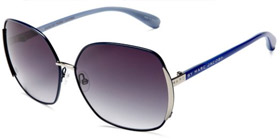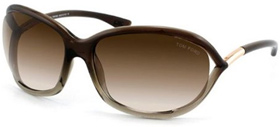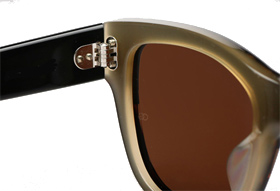The frames on your shades make a big difference to the comfort level. The material dictates the fit of your glasses as well as the type of hinges and attachments used to hold it all together. You’ll need to consider the size and weight of the glasses you want, and then find a material that corresponds with those limitations.
The frames of glasses are divided up into two primary categories with a third, smaller category for a fusion of the two.
Behind Bars… Or Metal Frames
Metals frames are more often than not thin, and provide a small edge around the perimeter of sunglasses. They’re usually made out of durable but lightweight materials like aluminum or stainless steel, and they’re designed to support the lenses without being overpowering like plastic frames can.
 Metal options can either be a shiny or matte finish, and they may blend into the lenses or contrast with them for the sake of style. Metal frame options include sunglasses like Maui Jim Breakwall and Marc by Marc Jacobs Women’s MMJ 098/S.
Metal options can either be a shiny or matte finish, and they may blend into the lenses or contrast with them for the sake of style. Metal frame options include sunglasses like Maui Jim Breakwall and Marc by Marc Jacobs Women’s MMJ 098/S.
Beyond general structure, this type tends to use nose guards in order to protect your face from the edge of the frame. While the frames aren’t sharp, they can be super uncomfortable to have sitting on your nose bridge. Additional padding is also sometimes used around the arms of the frames. The extra padding is usually rubber, and it’s there to make them more comfortable to wear as well as less likely to slip off.
Life in Plastic its Fantastic
There are a variety of plastics used to make larger framed sunglasses that are so trendy right now. More durable options seem to come out all the time, and modern synthetics provide a combination of strength and lightweight designs.
One of the newer options in frames for glasses is Zyl or cellulose acetate. This comes in many different constructions and there are several different ways to utilize acetates in sunglasses. They’re lightweight, and don’t break easily. Zyl glasses aren’t as sturdy as high quality metals, but they are often less expensive and easier to make.
Plastic frame options don’t usually have nose guards, so they can be more difficult to wear for people with small noses or little nose bridges. This type of eyewear often has flat, smooth sculpted pieces on the inside of the nose area in order to replace nose guards, but they don’t stay put as well as rubberized versions.
 Plastic frames enable sunglasses to come in a variety of colors that used to be reserved for lenses alone. Some glasses with plastic frames include Tom Ford Jennifer’s and Oakley GasCans.
Plastic frames enable sunglasses to come in a variety of colors that used to be reserved for lenses alone. Some glasses with plastic frames include Tom Ford Jennifer’s and Oakley GasCans.
Hybrid Design
As long as plastic and metal frames have been viable options, there has been a trend in combining the two. In general, combination frames have mostly plastic on the main frame with metal on the arms, but there are plenty of ways to vary the look. One example of combo frames is the Carrera Hot Aviators I reviewed here.
Try Not To Come Unhinged
The other part of the frame you have to be aware of is the hinges. While they’re usually hidden by the arm and frame of the sunglasses, a bad set of hinges can make life really uncomfortable. Sometimes, they’re noisy when you open and close the arms. While that’s not a functional issue, it’s annoying on a pair of sunglasses you may have paid a lot of money for. (Bad hinges can also break easily).
 Hinges can also catch long hair in them and, if you don’t realize it’s happened, take a clump of hair with them when you take the glasses off. It’s definitely worth saying this sort of problem is beyond uncomfortable! In fact, it can be downright painful.
Hinges can also catch long hair in them and, if you don’t realize it’s happened, take a clump of hair with them when you take the glasses off. It’s definitely worth saying this sort of problem is beyond uncomfortable! In fact, it can be downright painful.
Hinges usually come in three constructions and like frames, they’re made of either plastic or metal.
Work Together
Interlocking hinges are part of the frame and arm of the glasses, and they work by physically attaching the two parts of the sunglasses together. They’re great because they hide within the frame if it’s made of plastic. It’s basically a hidden barrel hinge.
Arms Go “Boing”
Spring hinges are the last alternative, and they are most often found on more expensive sunglasses that have a customized fit. Because of the spring construction, they’re designed to be tighter or close fitting. Tight doesn’t necessarily mean uncomfortable, and the hinge makes them adjustable so you get the right fit which basically molds to your head.
Material Matters
The construction of your sunglasses can matter for the sake of comfort and “wearability”. If you have a small nose or you’re sensitive to pressure on the sides of your head, it’s best to make sure you’re getting the right kind of frame so they’ll stay put and won’t cause headaches. Where lenses matter for quality of sight, the frames are just as important for the sake of comfort.


